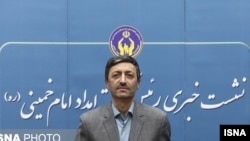Iranian Supreme Leader Ayatollah Ali Khamenei has appointed chief paymasters for the key parts of his $90 billion financial conglomerate, namely the Mostazafan Foundation and the Relief Committee.
Both organizations were meant to be charities for the underprivileged, but they are known to be Khamenei’s treasury, where cash is channeled to militant groups in the region or spent to further domestic political agenda.
On July 22, Khamenei appointed Parviz Fattah as head of the Mostazafan Foundation and Morteza Bakhtiari as chairman of the Relief Committee. Bakhtiari, who was previously the chief of staff for hard-line judiciary chief Ebrahim Raesi, replaced Fattah in the Relief Committee.
The appointments are significant from various viewpoints as the two men will run Khamenei’s treasury and act as his financial arm in Iranian politics.
The Mostazafan Foundation “donated” hefty sums to the supreme leader’s office in 2015 and 2016. The extent of such donations has been on the rise in recent years. The sums were given to the supervision and auditing section of Khamenei’s office.
Several other foundations operating under Khamenei’s office are also linked to that section and deposit sums that are used to run the day-to-day affairs of Khamenei’s office. Occasionally, these offices spend funds on real charitable purposes. In 2017, Khamenei’s gifts to the quake-stricken people in Western Iran came from one of these offices, the Barakat Foundation.
During the past two decades, the Khatam ol-Anbia headquarters of the Islamic Revolutionary Guards Corps (IRGC) has claimed the upper hand in financial transactions in Iran. The Mostazafan Foundation comes in second.
The new appointments could herald the start of a new period in the history of Khamenei’s financial cartel. Khamenei started restructuring his cartel in 2015, when the Barakat Foundation was launched as part of the administrative office of the Shrine of the 8th Shi’ite Imam in Mashhad.
Fattah’s mission in his previous position in Khamenei’s cartel was focused on the “eradication of poverty.” Fattah is known for being staunchly loyal to Khamenei and at the same time has managed to maintain a working relationship with the Rouhani administration. He is likely to follow the same approach as head of the Mostazafan Foundation.
The foundation has long been criticized for confiscating the assets of opposition figures. It was also criticized for failing to complete a highway that has been under construction for decades with the aim of linking Tehran to northern Caspian provinces. The highway would earn billions in toll revenues for the foundation and Khamenei’s office, and completing the highway looks to be one of Fattah’s main goals.
The foundation also plays a role in politics, supporting hard-line figures in the 2017 presidential elections, and many of its managers ran the campaign for hard-line candidate Raesi.
Fattah has recently said he would lend his all-out support to hardliners’ election campaign for the parliamentary elections in February 2020.
In other words, senior officials of various foundations in Khamenei’s cartel are not simply Khamenei’s treasurers. They are individuals trusted by Khamenei who collect funds to further political games such as elections.
From this point of view, changes in the financial cartel under Khamenei’s close control and supervision signal a meaningful trend that serves certain projects and individuals to further the political agenda of the supreme leader.







